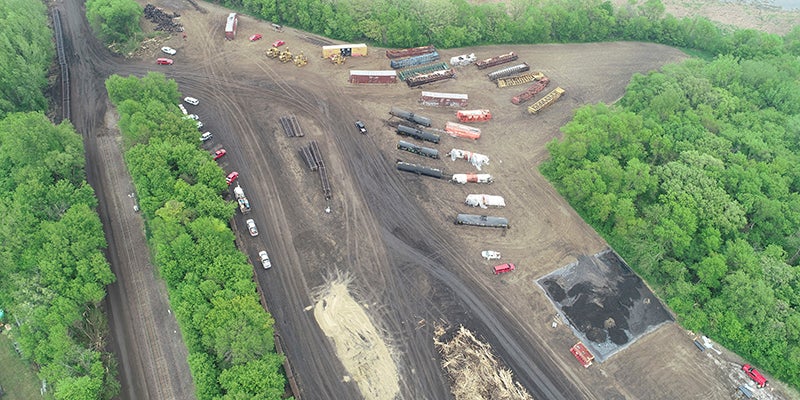VIDEO: Agencies working to clean up after derailment, hydrochloric acid spill
Published 1:20 pm Thursday, May 20, 2021

- Derailed Union Pacific train cars sit lined up in a staging area near the rail line in Albert Lea. Photo courtesy Freeborn County Sheriff's Office
|
Getting your Trinity Audio player ready...
|
The Union Pacific train line that was down because of a derailment was back up and running again Wednesday afternoon, Freeborn County’s emergency manager said.
Crews worked around the clock since the derailment Saturday to clear the rail of debris and damaged cars.
Water monitoring is taking place at six locations near the derailment site, including in an unnamed creek near Bridge Avenue, the wetland and creek 100 feet west of the site, three locations in Goose Lake, and one unnamed creek near the intersection of Greenwood Drive and Hammer Road. Sampling is being done by GHD, a contractor hired by Union Pacific.
Authorities have stated 40,000 gallons of hydrochloric acid spilled during the derailment, which took place Saturday afternoon. Once all of the derailed cars were removed from the Union Pacific property along the lake, responders have worked to neutralize the acid in the soil with the use of soda ash and in Goose Lake with crushed limestone to raise the pH to a healthier level for fish and other aquatic wildlife, said Cathy Malakowsky, communication strategist with the MPCA.
Malakowsky said generally fish and other aquatic life do best in pH levels of between 6.0 and 8.0.
Monitoring from Wednesday showed pH values between 7 and 9 directly east of the track bed, while values directly west of the track culvert, within the unnamed creek west of the site, showing values between 3 and 6.
Goose Lake itself is showing normal pH values between 6 and 7 in the northern portion of the lake, and pH levels are slowly improving in other areas of the lake, she said. Lower pH values between 3 and 4 were found along the south shore of Goose Lake toward the east end of the lake.
Malakwosky said there have been multiple observations of jumping and swimming carp throughout the lake, as well as floating mussels and snails. Most avian wildlife was observed avoiding the areas with lower pH.
She said though three dead carp and one large-mouth bass was observed, this is not considered a fish kill — which is technically defined by having five or more dead fish of the same species in the same area around the same time.
No other deceased wildlife was observed.
At the direction of the MPCA, an independent contractor is also onsite performing independent sampling and monitoring for a Natural Resources Damage Assessment. For this assessment, the state assesses the environmental harm from an incident and can seek compensation from the responsible parties to restore what was lost.



